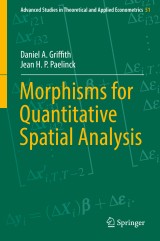Details

Morphisms for Quantitative Spatial Analysis
Advanced Studies in Theoretical and Applied Econometrics, Band 51
|
117,69 € |
|
| Verlag: | Springer |
| Format: | |
| Veröffentl.: | 07.03.2018 |
| ISBN/EAN: | 9783319725536 |
| Sprache: | englisch |
Dieses eBook enthält ein Wasserzeichen.
Beschreibungen
<div>This book treats the notion of morphisms in spatial analysis, paralleling these concepts in spatial statistics (Part I) and spatial econometrics (Part II). The principal concept is morphism (e.g., isomorphisms, homomorphisms, and allomorphisms), which is defined as a structure preserving the functional linkage between mathematical properties or operations in spatial statistics and spatial econometrics, among other disciplines. The purpose of this book is to present selected conceptions in both domains that are structurally the same, even though their labelling and the notation for their elements may differ. As the approaches presented here are applied to empirical materials in geography and economics, the book will also be of interest to scholars of regional science, quantitative geography and the geospatial sciences. It is a follow-up to the book “Non-standard Spatial Statistics and Spatial Econometrics” by the same authors, which was published by Springer in 2011. </div>
Preamble.- Introduction to Part 1: Spatial statistics.- Spatial autocorrelation and the p-Median problem.- Space-time autocorrelation.- The relative importance of spatial and temporal autocorrelation.- The spatial weights matrix and ESF.- Clustering: Spatial autocorrelation and location quotients.- Spatial autocorrelation parameter estimation for massively large georeferenced datasets.- Space-time data and semi-saturated fixed effects.- Spatial autocorrelation and spatial interaction gravity models.- General conclusions about spatial statistics.- Introduction to Part 2: Spatial econometrics.- Tinbergen-Bos systems: Combining combinatorial analysis with metric topology.- Time, space, or econotimespace?- Hybrid dynamical systems and control.- The W matrix revisited.- Clustering, some non-standard approaches.- Linear expenditure systems and related estimation problems.- Structural indicators galore.- Traveling with the salesman.- Complexer and complexer, said Alice.- General conclusions about spatial econometrics.- Epilogue.- References.- Subject index.- Author's index.
<div><div><b>Daniel A. Griffith</b>, an Ashbel Smith Professor of Geospatial Information Science at the University of Texas at Dallas, TX, USA, has published 18 books and over 200 articles appearing in geography, statistics, mathematics, economics, and regional science journals and other outlets. Griffith served as editor of Geographical Analysis from 2009 to 2014. Among his many awards, he is a fellow of the Royal Society of Canada, the American Statistical Association, and the Guggenheim Foundation. </div><div><b><br></b></div><div><b>Jean H. P. Paelinck </b>is an emeritus professor of the Erasmus University Rotterdam, and most recently was a distinguished Visiting Professor at George Mason University, VA, USA. As a (co-)author and (co-)editor, he has published around fifty volumes and over 400 articles, mainly on theoretical spatial economics and spatial econometrics. Paelinck has been awarded seven honorary PhDs and numerous other international distinctions, e.g. the Walter Isard Award in Regional Science.</div></div><div><br></div>
This book treats the notion of morphisms in spatial analysis, paralleling these concepts in spatial statistics (Part I) and spatial econometrics (Part II). The principal concept is morphism (e.g., isomorphisms, homomorphisms, and allomorphisms), which is defined as a structure preserving the functional linkage between mathematical properties or operations in spatial statistics and spatial econometrics, among other disciplines. The purpose of this book is to present selected conceptions in both domains that are structurally the same, even though their labelling and the notation for their elements may differ. As the approaches presented here are applied to empirical materials in geography and economics, the book will also be of interest to scholars of regional science, quantitative geography and the geospatial sciences. It is a follow-up to the book “Non-standard Spatial Statistics and Spatial Econometrics” by the same authors, which was published by Springer in 2011. <br>
Addresses morphisms in spatial analysis Presents both spatial statistics and spatial econometrics topics Features a special chapter on the relationship between spatial autocorrelation and spatial optimization Includes numerous applications of space-time data analysis
<div><br></div><br>
Diese Produkte könnten Sie auch interessieren:

Integration, Growth, and Cohesion in an Enlarged European Union

von: John Bradley, George G. Petrakos, Julia Traistaru

149,79 €

Rethinking Regional Innovation and Change: Path Dependency or Regional Breakthrough

von: Gerhard Fuchs, Philip Shapira

149,79 €














